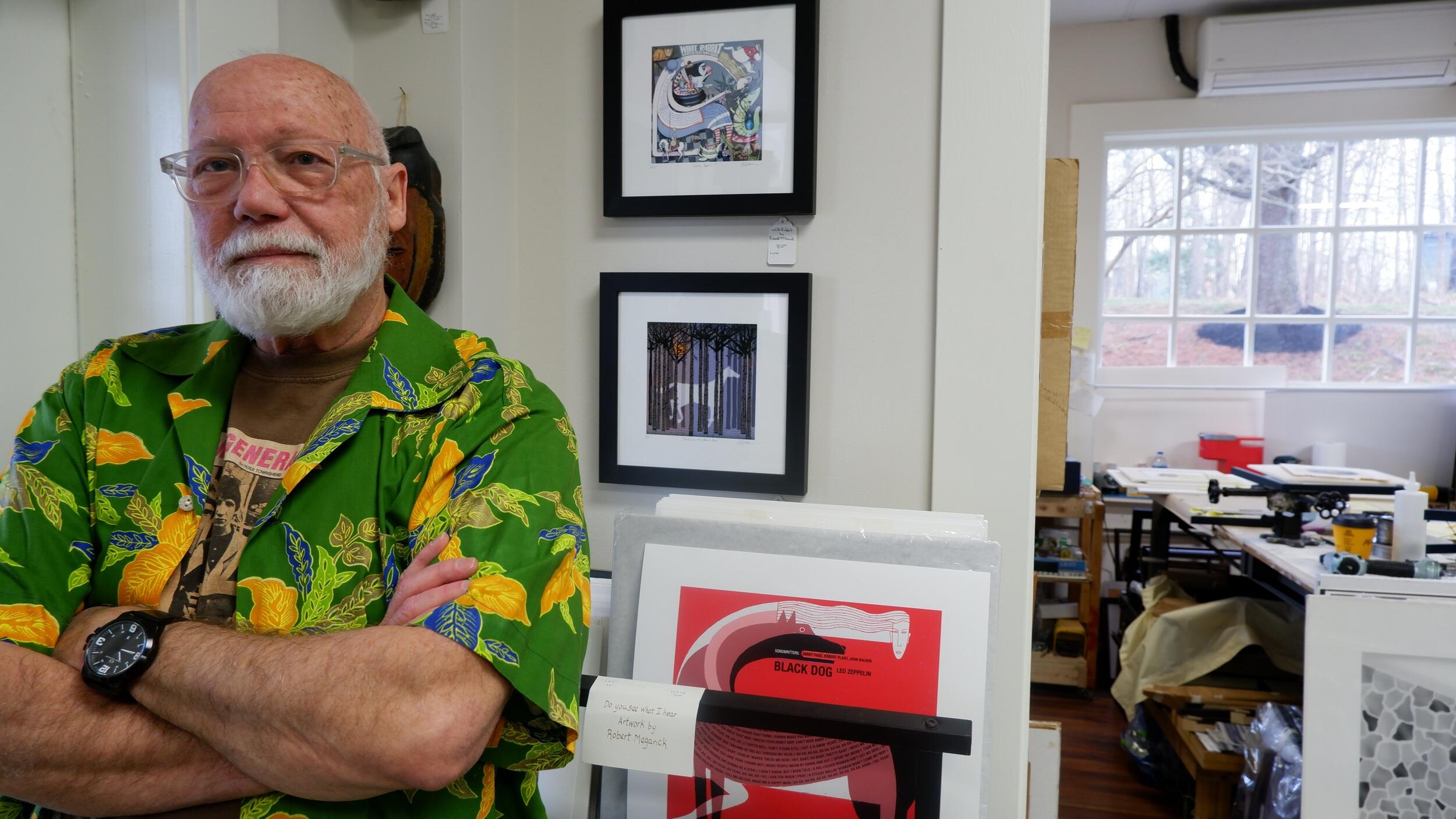
April 4, 2022
The lockdown didn’t stop Robert Meganck and other artists like him, it just forced them to find a different path
Share this story
Reese Witherspoon took up painting. Tony Hawk sang Nirvana with Mikey and His Uke. Robert Meganck illustrated the songs he heard. When the world locked down, artists of all genres could not stop creating, even if they had to find new ways to do it.
“When you put a creative person in a box, they will look for a way out,” said Meganck, professor emeritus in the Department of Communication Arts at Virginia Commonwealth University, where he taught for 40 years. “The pandemic nearly eliminated my freelance illustration projects, but the elimination of external projects doesn’t change the internal drive to create something, it just forces you to find a different path.”
Meganck’s path led him to create “See What I Hear” — a series of illustrated songs — and has earned him national recognition with an industry award for music-inspired art.
His visual interpretation of Led Zeppelin’s “Black Dog” won Communication Arts magazine’s 63rd annual illustration competition. From 3,689 entries, 145 illustrations were selected. The magazine will publish the piece in its May/June issue.
A piece inspired by Lead Belly’s “In the Pines” was recognized for excellence by American Illustration and will be included in its annual AI-40, which represents the year’s best illustrations.
‘Old people just grow lonesome’
It started with the death of folk singer/songwriter John Prine in April 2020.

“I’ve been a big fan of John’s music since his coffeehouse days in 1971,” Meganck said. “I love all his albums and was left wondering how to process the fact that there would be no more. I wrote a little piece to send to friends that talked about the content of his songs, the descriptive beauty of his lyrics and what they mean to me.”
Meganck found himself copying the lyrics from “Hello in There,” a Prine song about the loneliness of old age, and pasted them within a 12-inch by 12-inch page, the size of an album cover. He digitally painted an image that represented the lyrics over the top of the text. The work, he said, gave him a certain level of closure.
A few days later, he was listening to a Leonard Cohen album — another favorite — when he thought about how he would illustrate the song “Ballad of an Absent Mare.” Friends and family seemed to enjoy his song interpretations, so he followed up with illustrations of songs by Paul Simon, John Lennon and Paul McCartney, and Mick Jagger and Keith Richards.
At that point, he realized the project was a fulfilling way to keep creatively active during the pandemic. Two years — and 110 illustrations — later, he’s still posting a song on a weekly basis.
“No one thought the pandemic would still be affecting our lives two years later,” he said. “It just sort of evolved into a series.”
Shifting is part of the creative process
Meganck approaches each piece by listening to the song, examining the lyrics and exploring its meaning.

“The road to finish can take twists and turns, and the final may look very different from the initial idea,” he said. “Allowing yourself to shift is part of the creative process.”
While he always plays music when he works, it’s “not the same song over and over,” he said. “At the start, I do generally listen to albums by the same performer, but I also move on to others.”
He chooses songs from a variety of genres — including rock, country, folk, punk and blues — from his own collection of CD and vinyl, iMusic and streaming services. Everything is done digitally. Most start as sketches on an iPad, but all are finished using some combination of Adobe Photoshop and Illustrator. After he comes up with the initial concept, it takes one to three days to complete the illustration.
“The series is titled ‘See What I Hear,’ because they are visualizations of what I listen to and love,” Meganck said. “Four of the songs did begin as commissions, but before I accepted each of these, I had to listen to them several times, read and understand the lyrics. Before I accepted the commission, I had to believe that I could interpret them accurately. I also get song suggestions from friends and family. My daughter, a VCU grad, is big on letting me know what songs she would like me to do. Also of note is that four of the songs are instrumentals, so I had to draw from the title and tone of these songs.”
‘The arts make your life worth living’
It’s difficult for Meganck to say what he would be doing if the pandemic hadn’t forced him to reevaluate his downtime.

“Music is my muse,” he said. “For someone like me, who enjoys live performances, [this project] was a way for me to express my love of music without the venue option.”
And, he mused, what could be better than spending the bulk of his day drawing? “I can’t imagine doing anything else.”
The truth is, Meganck added, that he is an artist not because he’s so good at it, but because growing up, he was so bad at everything else, and he never really wanted to do anything else.
“The arts won’t save your life, but they will make your life worth living. If you think about life without the visual arts, the performing arts and literature, what would give it meaning?”
The “See What I Hear” collection can be viewed and purchased online at Saatchi Art. Select pieces are on display and for sale at Collector’s Gallery at 13228 Midlothian Turnpike, Midlothian, Virginia.
Subscribe to VCU News
Subscribe to VCU News at newsletter.vcu.edu and receive a selection of stories, videos, photos, news clips and event listings in your inbox.







